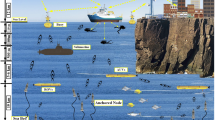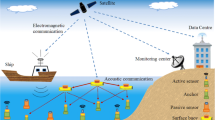Abstract
Interest in wideband and medium distance underwater acoustic communication systems is increasing due to the practical application of underwater Internet of Things (IoT) networks. In this paper, we propose a simplified empirical channel model for the medium distance underwater acoustic channels based on real measurement results. The simple and tractable channel model is critical for the development of advanced underwater communications technology. The underwater channel measurements were performed at 20 m sea water depth, the transmitters (TXs) were located at 5 m and 15 m from the bottom, the receivers (RXs) were located at 4 m, 8 m, 12 m, and 16 m from the bottom, and the TX–RX distances were 21 m, 71 m, 127 m, and 273 m. We derived the path loss from the measured dataset, and modified the log-distance model to create a model suitable for an underwater IoT channel. Numerical results show that the proposed model is accurate and reliable enough to use in the development of advanced underwater communication technologies.













Similar content being viewed by others
References
Goyal, N., Dave, M., & Verma, A. K. (2019). Protocol stack of underwater wireless sensor network: Classical approaches and new trends. Wireless Personal Communications, 104, 995–1022.
Stojanovic, M., & Preisig, J. (2009). Underwater acoustic communication channels: Propagation models and statistical characterization. IEEE Communications Magazine, 47(1), 84–89.
Stefanov, A., & Stojanovic, M. (2011). Design and performance analysis of underwater acoustic networks. IEEE Journal on Selected Areas in Communications, 29(10), 2012–2021.
Gomathi, R. M., & Manickam, J. M. L. (2019). Energy efficient static node selection in underwater acoustic wireless sensor network. Wireless Personal Communications, 107, 709–727.
Akyildiz, I. F., Pompili, D., & Melodia, T. (2005). Underwater acoustic sensor networks: Research challenges. Ad Hoc Networks, 3(3), 257–279.
Cai, H., Xu, B., Jiang, L., & Vasilakos, A. V. (2017). IoT-based big data storage systems in cloud computing: Perspectives and challenges. IEEE Internet of Things Journal, 4(1), 75–87.
Zhang, Q., Yang, L. T., Chen, Z., Li, P., & Bu, F. (2019). An adaptive dropout deep computation model for industrial iot big data learning with crowdsourcing to cloud computing. IEEE Transactions on Industrial Informatics, 15(4), 2330–2337.
Sun, Y., Song, H., Jara, A. J., & Bie, R. (2016). Internet of things and big data analytics for smart and connected communities. IEEE Access, 4, 766–773.
Bera, S., Misra, S., Roy, S. K., & Obaidat, M. S. (2018). Soft-WSN: Software-defined WSN management system for IoT applications. IEEE Systems Journal, 12(3), 2074–2081.
Wazid, M., Das, A. K., Odelu, V., Kumar, N., Conti, M., & Jo, M. (2018). Design of secure user authenticated key management protocol for generic IoT networks. IEEE Internet of Things Journal, 5(1), 269–282.
Morabito, R., Cozzolino, V., Ding, A. Y., Beijar, N., & Ott, J. (2018). Consolidate IoT edge computing with lightweight virtualization. IEEE Network, 32(1), 102–111.
Sun, X., & Ansari, N. (2016). EdgeIoT: Mobile edge computing for the internet of things. IEEE Communications Magazine, 24(16), 22–29.
Bradbeer, R., Law, E., & Yeung, L. F. (2003). Using multi-frequency modulation in a modem for the transmission of near-realtime video in an underwater environment. In Proceedings of IEEE international conference on consumer electronics (pp. 360–361).
Chitre, M., Ong, S. H., & Potter, J. (2005). Performance of coded OFDM in very shallow water channels and snapping shrimp noise. Proceedings of MTS/IEEE OCEANS Conference, 2, 996–1001.
Bocus, M. J., Agrafiotis, D., & Doufexi, A. (2018). Underwater acoustic video transmission using MIMO-FBMC. In 2018 OCEANS—MTS/IEEE Kobe Techno-Oceans (OTO).
Bocus, M. J., Agrafiotis, D., & Doufexi, A. (2018). Real-time video transmission using massive MIMO in an underwater acoustic channel. In 2018 IEEE wireless communications and networking conference (WCNC).
Kan, W., Wang, J., Zhou, H., & Xu, C. (2018). Design of underwater acoustic communication system based on OFDM. In 2018 2nd IEEE advanced information management, communicates,electronic and automation control conference (IMCEC).
Qarabaqi, P., & Stojanovic, M. (2013). Statistical characterization and computationally efficient modeling of a class of underwater acoustic communication channels. IEEE Journal of Oceanic Engineering, 38(4), 701–717.
Truhachev, D., Schlegel, C., Bashir, M., & Bousquet, J.-F. (2018). Modeling of underwater acoustic channels for communication system testing. In OCEANS 2018 MTS/IEEE Charleston.
Qiao, G., Babar, Z., Ma, L., Wan, L., Qing, X., Li, X., & Bilal, M. (2018). Shallow water acoustic channel modeling and MIMO-OFDM simulations. In 2018 15th international bhurban conference on applied sciences and technology (IBCAST)
Naderi, M., Zajic, A. G., & Patzold, M. (2018). A nonisovelocity geometry-based underwater acoustic channel model. IEEE Transactions on Vehicular Technology, 67(4), 2864–2879.
Lee, B. M., & Yang, H. (2019). Massive MIMO with massive connectivity for industrial internet of things. IEEE Transactions on Industrial Electronics,. https://doi.org/10.1109/TIE.2019.2924855.
Lee, B. M., & Yang, H. (2018). Massive MIMO for industrial internet of things in cyber-physical systems. IEEE Transactions on Industrial Informatics, 14(6), 2641–2652.
Lee, B. M. (2018). Calibration for channel reciprocity in industrial massive MIMO antenna systems. IEEE Transactions on Industrial Informatics, 14(1), 221–230.
Lee, B. M. (2018). Improved energy efficiency of massive MIMO-OFDM in battery-limited IoT networks. IEEE Access, 6, 38147–38160.
Lee, B. M., & Kim, Y. (2013). An adaptive clipping and filtering technique for PAPR reduction of OFDM signals. Circuits, Systems, and Signal Processing, 32(3), 1335–1349.
Okumura, Y., Ohmori, E., Kawano, T., & Fukuda, K. (1968). Field strength and its variability in VHF and UHF land-mobile radio service. Review of the Electrical Communication Laboratory, 16(9), 825–873.
Hata, M. (1980). Empirical formula for propagation loss in land mobile radio services. IEEE Transactions on Vehicular Technology, 29(3), 317–325.
Friss, H. T. (1946). A note on a simple transmission formula. Proceedings of the IRE, 34(5), 254–256.
Rappaport, T. S. (2002). Wireless communications: Principles and practice (2nd ed.). Upper Saddle River: Prentice Hall.
Cho, Y. S., Kim, J., Yang, W. Y., & Kang, C. G. (2010). MIMO-OFDM wireless communications with MATLAB. Hoboken: Wiley-IEEE Press.
Robertson, I., Somjit, N., & Chongcheawchamnan, M. (2016). Microwave and millimetre-wave design for wireless communications. Hoboken: Wiley.
Stojanovic, M. (2006) On the relationship between capacity and distance in an underwater acoustic communication channel. In Proceedings of the 1st ACM international workshop on underwater networks, Los Angeles, CA, USA, 25 Sept. 2006 ACM: New York, NY, USA, pp. 41–47.
Shannon, C. E. (2001). A mathematical theory of communication. ACM SIGMOBILE Mobile Computing and Communications Review, 5(1), 3–55.
Bouvet, P.-J., & Loussert, A. (2010). Capacity analysis of underwater acoustic MIMO communications. In IEEE OCEANS’10, Sydney, May 24–27.
Gao, M., Foh, C. H., & Cai, J. (2012). On the selection of transmission range in underwater acoustic sensor networks. Sensors, 12, 4715–4729.
Urick, R. (1983). Principles of underwater sound. New York: McGraw-Hill.
Duro, R. J., & Pena, F. L. (2012). Digital image and signal processing for measurement systems. Denmark: River Publishers.
Haykin, S. (1995). Adaptive filter theory (3rd ed.). Upper Saddle River: Prentice Hall.
Goldsmith, A. (2005). Wireless communications. Cambridge: Cambridge University Press.
Molisch, A. F. (2011). Wireless communications (2nd ed.). Hoboken: Wiley.
Butler, L. (1987). Underwater radio communication. Amateur Radio.
Sharif, B. S., Neasham, J., Hinton, O. R., & Adams, A. E. (2000). A computationally efficient Doppler compensation system for underwater acoustic communications. IEEE Journal of Oceanic Engineering, 25(1), 52–67.
Abdelkareem, A. E., Sharif, B. S., Tsimenidis, C. C., & Neasham, J. A. (2011). Time varying Doppler-shift compensation for OFDM-based shallow Underwater Acoustic Communication systems. In 2011 Eighth IEEE international conference on mobile ad-hoc and sensor systems Oct. 17–22.
Li, B., Zhou, S., Stojanovic, M., Freitag, L., & Willett, P. (2008). Multicarrier communication over underwater acoustic channels with nonuniform doppler shifts. IEEE Journal of Oceanic Engineering, 33(2), 198–209.
Abdelkareema, A. E., Sharifbc, B. S., & Tsimenidisb, C. C. (2016). Adaptive time varying doppler shift compensation algorithm for OFDM-based underwater acoustic communication systems. Ad Hoc Networks, 45, 104–119.
Domingo, M. C. (2012). An overview of the internet of underwater things. Journal of Network and Computer Applications, 32(6), 1879–1890.
Zhou, Z., Yao, B., Xing, R., Shu, L., & Bu, S. (2016). E-CARP: An energy efficient routing protocol for UWSNs in the internet of underwater things. IEEE Sensors Journal, 16(11), 4072–4082.
Kao, C.-C., Lin, Y.-S., Wu, G.-D., & Huang, C.-J. (2017). A comprehensive study on the internet of underwater things: Applications, challenges, and channel models. Sensors, 17, 1477.
Sharif-Yazd, M., Khosravi, M. R., & Moghimi, M. K. (2017). A survey on underwater acoustic sensor networks: perspectives on protocol design for signaling, MAC and routing. Journal of Computer and Communications, 5, 12–23.
Che, X., Wells, I., Dickers, G., Kear, P., & Gong, X. (2010). Swansea Metropolitan University, Re-Evaluation of RF electromagnetic communication in underwater sensor networks. IEEE Communications Magazine, 48, 143–151.
Bereketli, A. (2013). Remotely powered underwater acoustic sensor networks. Ph.D. dissertation, Middle East Technical University.
Lee, H. K., Cheon, J. H., & Lee, B. M. (2020). Improved underwater horizontal ranging algorithm using reflected acoustic wave. Wireless Personal Communications, 111, 1775–1786.
Lee, H. K., Heo, S. W., & Lee, B. M. (2017). Trellis code design of block interleaved CIOD-STBCs for time varying channels. IEEE Transactions on Vehicular Technology, 66(11), 10542–10545.
Funding
This research was supported by the Basic Science Research Program through the National Research Foundation of Korea (NRF) funded by the Korea government (MSIT)(Grant Numbers: NRF-2019R1A4A1023746) and Korea Electric Power Corporation (Grants R18XA02).
Author information
Authors and Affiliations
Corresponding author
Additional information
Publisher's Note
Springer Nature remains neutral with regard to jurisdictional claims in published maps and institutional affiliations.
Rights and permissions
About this article
Cite this article
Lee, H.K., Lee, B.M. An Underwater Acoustic Channel Modeling for Internet of Things Networks. Wireless Pers Commun 116, 2697–2722 (2021). https://doi.org/10.1007/s11277-020-07817-x
Published:
Issue Date:
DOI: https://doi.org/10.1007/s11277-020-07817-x




